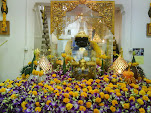"Wan Chai"(the day of offering)
On this day, apart from preparing new clothes to wear, people will make desserts to offer to monks and to give to friends and relatives. This act of generosity is also a way to show off each family's cooking skills. Well-to-do families will make a large amount of desserts to give away to others. In the past it was not possible to buy desserts since everyone made their own. Nowadays, some Thais follow western traditions by buying and giving cakes to others, as it is more convenient to do so rather than cooking.
Offering food to monks
On the dawn of the first day of the incoming year, people will prepare the best varieties of food to offer to monks. They will also dress up in their best attire. After giving alms to monks, the monks will eat the offered food in the temple hall. People will then go home after the monks have finished their meal
Making Sand Pagodas
There is no specific date for making sand pagodas. It can be done on any day close to Songkran in the temple grounds or on a riverbank. People in Kamphaeng Phet province also make offerings to monks on a riverbank. People in Nakhon Si Thammarat build their sand pagodas twice; first in a temple on the last day of the outgoing year, and then in the grounds of their houses on the first day of the incoming year. The sand used for building pagodas is often taken from a riverbank.
Releasing birds and fish
This tradition began a long time ago and it is normally done during the Songkran Festival. Before the festival, the weather is usually very warm and there is not enough water in ponds and rivers for fish to stay; as a result, people will go out to catch fish in dry ponds. Small fish which cannot be eaten will be kept at home until Songkran when there is more water, and then they will be released back to their natural habitat. This tradition has evolved over time and is widely practiced nowadays. At present, in addition to fish, people also free birds as an act of merit-making
Bangsukun Atthi
Apart from releasing birds and fish, there is also a ritual performed by monks to the remains of the deceased in order to pass on merit to them. This ritual is known as Bangsukun Atthi. It will be performed once during the Songkran Festival on any of the three days. In the past, Thais did not bring the ashes of the deceased back home, but the remains were buried under the Bodhi tree in a temple and monks would be invited to perform the ritual there.
This ritual is believed to be local and is not influenced by Indian traditions because the Indians usually discard ashes in a water source, especially into the Ganges River. In some areas in Thailand, people also perform a rite to worship guardian spirits of the village and town. In Central Thailand, household chores such as gathering firewood and fetching water are prohibited during Songkran, and these chores must be done beforehand
Song Nam, Rot Nam, and Sat Nam
To bathe a Buddha image, people will first make an offering of flowers, candles, and incense sticks to the image. Then they will sprinkle lustral water signifying bathing onto the image as a gesture of respect. A procession of the Buddha image will be made prior to the bathing. After that people will also bathe a Buddhist monk, usually the abbot, by pouring lustral water over him. The abbot will change into a new robe offered to him by laymen, and then he will give a sermon and bless the people who attend these bathing rituals. Besides, people will also call on elders and respected people to ask for their blessings.
After that, people will play by splashing water at one another. A feast in the temple grounds will follow. Traditional desserts will be served there.
The Songkran Festival is very much related to water, since people believe that water splashing will induce abundant rainfall in the incoming year. Water is also a symbol of fertility and is used to clean bad things. As a result, water is used widely in different ceremonies and rites of passage.
Rod Nam Dam Hua
People in Northwest Thailand conduct the bathingritual to the elders and respected ones on New Year's Day. Apart from flowers, candles, incense sticks, and new clothes, betel nuts, Acacia water, and traditional perfume are also part of the gifts presented. Betel nut is a symbol of respect and hospitality. In the old days, Acacia water was used as soap. Once the elders receive the gifts, they will sprinkle the Acacia water and the perfume on top of the younger family members' heads to give them blessings.
Nowadays, some people still bring their new clothes and personal belongings along with other ritual objects; such as, banana, sugarcane, and jackfruit leaves, to the temple so that Buddhist monks can sprinkle them with holy water in order to purify the clothes. These clothes and objects will be kept untouched for days for auspiciousness.
Monday, 13 April 2009
Subscribe to:
Post Comments (Atom)


No comments:
Post a Comment